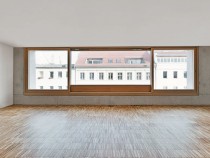
© Simon Menges
Constructed with lightweight concrete, the present building accommodates itself to its late-19th-century environment as a monolithic housing structure. The restrained coloration and the articulation of the individual storeys reflect features of the surroundings, while at the same time lending the development an expression of its own that stresses the volume of the construction material. With its large areas of glazing, the structure forms a bold contrast to the neighbouring buildings with their facades punctuated by rows of rectangular windows. Each floor opens on to the street in the form of a single, broad window. This is divided by solid wood frames into a central bay of fixed glazing flanked on both sides by sliding elements.
The entire detailing of the building is also minimal: the windows, with transparently coated larch frames, are set in precisely formed openings in the concrete structure. The lightweight concrete that was used assumes both load-bearing and thermally insulating functions – a solution that was possible only with an independent application of energy-saving regulations. Even if the outer walls, with a thickness of 55 cm, achieve just the minimum thermal insulation level required, primary-energy needs and heat losses resulting from thermal transmission remain within the prescribed limits as a result of the compact building form, the use of triple glazing and the cogeneration plant in the basement.
The layout of the shuttering selected for the exposed concrete surfaces was based on the dimensions of system formwork. This helped to achieve a high visual quality at reasonable costs. The slightly offset layout of the shuttering to each floor facilitated not only a fine three-dimensional accentuation of the building volume, but also an unobtrusive integration of the working joints between the various concreting stages.
The entire detailing of the building is also minimal: the windows, with transparently coated larch frames, are set in precisely formed openings in the concrete structure. The lightweight concrete that was used assumes both load-bearing and thermally insulating functions – a solution that was possible only with an independent application of energy-saving regulations. Even if the outer walls, with a thickness of 55 cm, achieve just the minimum thermal insulation level required, primary-energy needs and heat losses resulting from thermal transmission remain within the prescribed limits as a result of the compact building form, the use of triple glazing and the cogeneration plant in the basement.
The layout of the shuttering selected for the exposed concrete surfaces was based on the dimensions of system formwork. This helped to achieve a high visual quality at reasonable costs. The slightly offset layout of the shuttering to each floor facilitated not only a fine three-dimensional accentuation of the building volume, but also an unobtrusive integration of the working joints between the various concreting stages.






